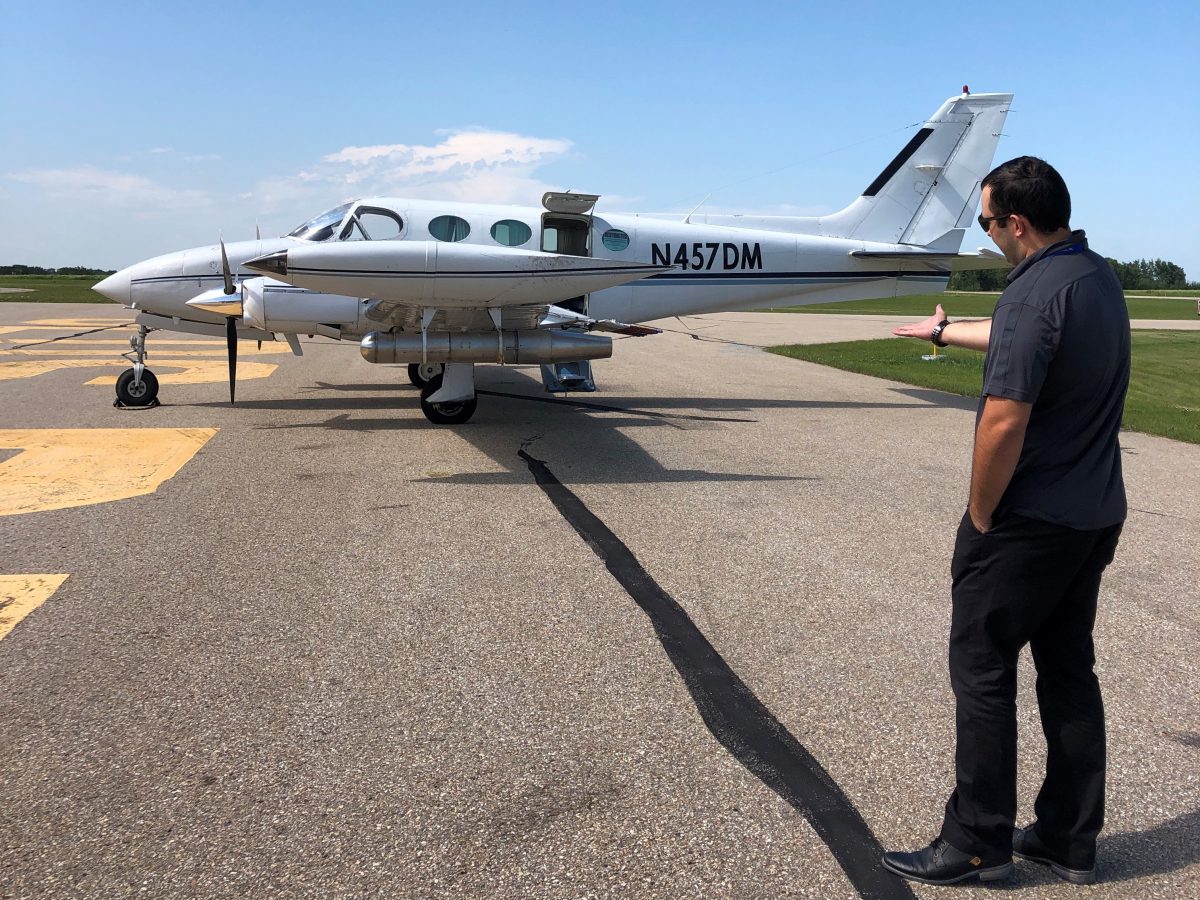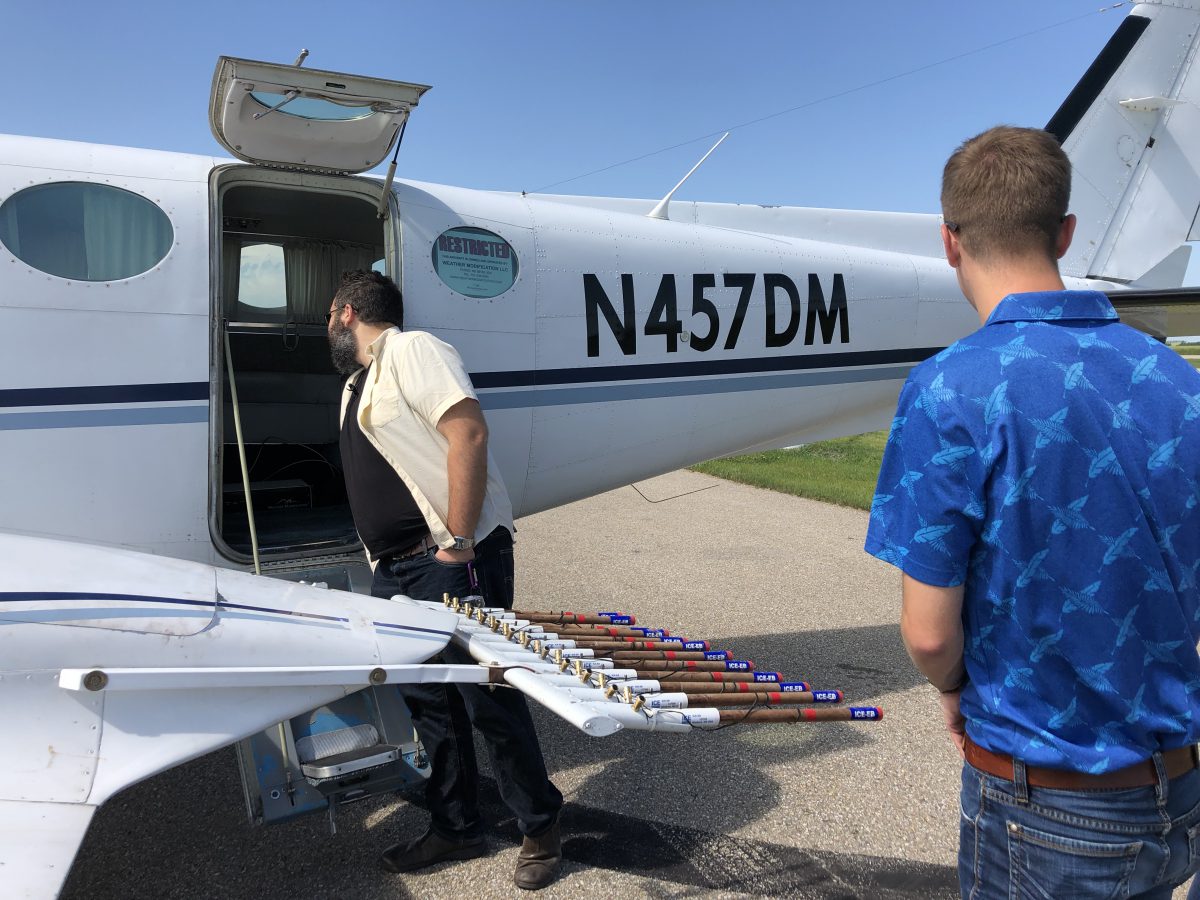If you’ve ever scrolled through any photos or videos tagged #abstorm on social media, you’ve witnessed the extreme weather that Alberta experiences each year. According to Global News, Alberta gets hit with an average of 40 major storms every summer.
Alberta is home to over half of all catastrophic hail events in Canada. In June 2020, a hailstorm that hit Calgary and the surrounding area caused over $1.3 billion in insured damage, making it the fourth most expensive natural disaster in Canadian history. Other notable storms in 2012 (Calgary) and 2014 (Airdrie) each caused over $500 million dollars in insured damage. Reducing the impact and severity of these storms is is extremely important in order to minimize the amount of damage and insurance claims that can occur.
What is the Alberta Hail Suppression Project?
The Alberta Hail Suppression Project (AHSP) is a program funded by the Alberta Severe Weather Management Society (ASWMS), which is a non-profit organization established by Alberta’s largest insurance companies. The program has been running since 1996 with the goal of mitigating the amount of hail damage affecting urban property such as homes and vehicles. The program uses seeding planes that fly between the start of June until September 15th every year.
Cloud seeding, explained
The project utilizes cloud seeding, which is a process involving the use of silver iodide in the form of smoke to produce ice crystals that are believed to reduce the size of hail. This process turns hail that could reach the size of a golf ball into smaller hailstones or rain as it warms before reaching the ground. This small hail or rain does not damage property, and significant losses are therefore averted.
Cloud seeding does not make storm clouds disappear and does not “turn off” the hail, but it does reduce the size of hailstones. Cloud seeding is done for various reasons around the world, including rain and snow enhancement, but in Alberta it is only used for hail mitigation.
How are seeding areas chosen?
Since there are only 5 seeding planes, priority is given to storms based on their severity and the population of the community being threatened. The area seeded runs from just south of High River, all the way up to Rocky Mountain House and Lacombe. This covers the cities of Calgary, Airdrie, Red Deer, Okotoks, Cochrane and others within the protected area.
Is silver iodide safe?
While concerns may arise over the use of silver iodide in storm clouds, the quantity used is very small relative to the amount of water in the storms. The level of silver iodide found in storm water that has been seeded is similar to the natural level of silver iodide found in surface or tap water.
Why does hail damage still occur?
You might be wondering, if Alberta has this program, why does damaging hail still sometimes manage to slip through? Large storms can be unpredictable, with four or five feeder clouds popping up at the same time. If these feeder clouds are quickly merging with the storm, a seeding plane may only be able to seed two or three of those clouds.
The team at Fuse Insurance went on a tour of the Alberta Hail Suppression Project facility and got a close-up look at the seeding aircrafts and software used to predict severe weather conditions. The radar used by AHSP is available to the public on the Weather Modification Inc. (WMI) Radar website here. It serves as a helpful and fascinating tool on stormy days and pinpoints where the seeding planes are located, as well as what storm cells are expected to do. Checking the radar and daily forecast before stepping outside could save you from being caught in dangerous storm conditions.
If you are looking for even more information and research on the Alberta Hail Suppression Project, check out this technical report: Twenty Seasons of Airborne Hail Suppression in Alberta, Canada.
How to protect your Canadian business from other natural disasters: Preparing Your Business for a Flood and Preparing Your Business for Wildfires
Fuse Insurance Ltd. is the evolution of the commercial insurance brokerage, and the first of its kind in Western Canada. Backed by policies from a selection of A-rated insurers, Fuse Insurance can provide coverage for businesses large and small from almost any industry. For further information or to fill out our easy online application, click here or call us at 1-866-387-FUSE (3873) for more details.









Why is NE Calgary not being seeded. Same excuse last week and again June 20th. They are seeding the South whereas NE Calgary gets hammered??!!
I work in insurance sector. Due to sudden and unimaginable hail on June 13,2020 NE quadrant of Calgary is being looked upon as a black sheep of the heard from the profitability side of the business which will result in heavy penalties. People in this area have been through the same tyranny of whether in June, 2020. I, personally have lost my cars and severe damage to my property.
I need to know why was this this area not seeded? Any mistake or were the other areas prioritized over this one?
One should realize climate change is contributing to this increase in severe weather. Alberta is the centre of it all. The insurance bureau published an article in 2018 stating that between 2010 and 17, 61% of all natural disaster claims in CANADA which includes fire hail, wind, floods etc, were in Alberta! Think about that! 39% for the other 9 provinces and 3 territories! So get ready folks, it’s coming and it does not look positive for Alberta.ni recently drove from Lake Winnipeg in MB to Cold Lake and crossed 8 rivers. All were in flood stage.
That doesn’t make any sense.
to ‘David’:
‘climate change’ is NOT increasing incidence rate of severe weather. Read for example https://www.thegwpf.org/content/uploads/2022/05/UKWeather2020-21.pdf.
Read geography, physics, and history including that:
– the flooding in Calgary a few years ago was a once-in-75 year event
– read history: the Red River floods every decade or so, the North Saskatchewan River flooded high in 1915,
– snow melt in the mountains creates high water, amount of snow nd rate of melting varies from year to year
– look at a map: you drove in the area of the North and South Saskatchewan Rivers which come from the Rocky Mountains
– when did you drive? Spring snow melt does push rivers high, depending on how fast the snow melts.
Facts not negative fantasies.
‘David’:
Your period of statistics is too short to be meaningful.
Look at recent weather in ON – severe windstorm that went through large populated areas, whereas last time it only went through one.
Check when Calgary got flooded (answer: 2013 which is within your short time span).
Check when tornados occurred – they do in ON and near Edmonton
Check whether incidence of hail damage in mid-south AB has increased much in past few decades
And learn that Humans cannot cause runaway climate warming, which is not and cannot happen.
Climate has been warming slowly since the end of a cool era that drove them out, shown by accurate thermometers like weather balloons and satellite sensors, and tide gages.
The effect CO2 can have is small, limited by the ‘saturation’ effect of overlap of spectra of carbon dioxide and dihydrogen monoxide vapour, most of the increase has already been realized.
Earth was warmer and climate stable in the Medieval Warm Period when Vikings farmed southwest Greenland.
Read Alex Epstein’s book ‘Fossil Future’ for facts of climate and the benefits of fossil fuels and CO2 to humans, and more at http://www.friendsofscience.org.
To Ed:
Agree David does not make sense.
He is grabbing a short period, doesn’t define ‘flood stage’, doesn’t say when his trip was (rivers will be high in spring, the _ Saskatchewan named ones start in the Rockies so will be high long after local ones are from prairies snow melt), doesn’t name them (may have crossed some rivers more than once as they meander), doesn’t say where on Lake Winnipeg he started from though perhaps north or south end as Lake Winnipegosis and others limit road building. (Rivers to the WNW of Winterpeg are high some years, just as the Red River is and long has been – that is why Winterpeg built a big ditch through the city.)
And a questionable source, though he is probably not wise enough to figure it out – the IBC lies about climate, as some members try to justify price increases – other members are more accurate. (Insurers tend to price to low to get business then want to raise rates, many aren’t smart at evaluating risk – I have several examples from my experience.)
He comes across as flapping from emotions of a negative mindset.
So Calgary is saved, yay. Who do you think gets their hail? Even if marginally smaller it still hits someone. This summer it has been us again. Every time there is a dark cloud there is a plane heading into it. Weather Modification Inc. has to use up all the seeding budget…
Over the years I have had so many hail claims that I cannot get insurance any more. (Or can’t afford it) yet the insurance companies are the ones funding this. Is this fair? If we get the hail knocked out by the insurance companies trying to save the big cities, should we not at least get some kind of reduction in our policies?
The conversations above make it sound like hail seeding is normal and there are no consequences. My whole property looks like a chopped salad and I still have snow drifts of marble sized hail 8 hours after the actual storm. But I’m glad Calgary is ok….
Blayne Massong
August 3 rd ,2022
Did you hear the hail size earlier this week. It does make sense to seed the clouds to make the hail size smaller. This proves it will cause less damage to everything.